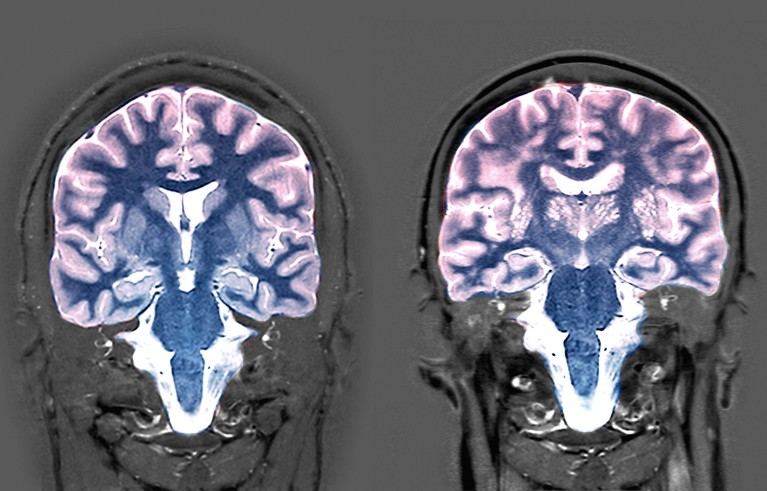 |
| This image shows aging of human brains. Brain of a 25 year old and a 74 year old (left to right, respectively) (Naddaf, 2024). |
In a recent study, researchers in China looked into brain scans and blood samples of 10,949 healthy adults of varied ages to estimate brain age gap (BAG). BAG is a measurement between an individual's actual age and their "brain age" (calculated by hundreds of structural features such as: amount of white matter, cortex thickness, brain volume, etc). This measurement can be used to indicate brain health, and on average the participant's brain age was found to be around three years younger or older than their actual age.
One of their targets for this study was to determine what biomarkers/proteins are associated with accelerated brain aging, for which 8 were identified (and five additional proteins for slower brain aging). Some of these proteins are also known to be involved in brain function, such as movement, cognition, and mental health. One of the proteins, brevican (BCAN), is known to be a key factor in physiological and pathophysiological plasticity processes (Frischknect et. al, 2012). It is noted that higher levels of BCAN are correlated with slower brain aging; interestingly, those with Alzheimer's have less BCAN than healthy individuals. Another interesting finding that was noted is that at ages 57, 70, and 78 years old very distinct brain aging symptoms are noted. 57 year old brains exhibited changes in proteins for metabolism, would healing, and mental health, while at age 70 brains proteins showed changes that heightened risks for dementia and strokes. Lastly, at 78, it was seen that proteins associated with immunity and inflammation were changed.
These are extremely interesting findings when thinking in context of our genetic predisposition for certain brain disorders. Neuroscientist Mark Mattson commented that our next step is to answer where the proteins are coming from (and discovering the mechanisms in which they coded for). However, this study opens the door to identifying the genes and proteins that should be targeted for those with age-related brain disorders. Also, because they identified the proteins associated with these brain disorders, we may be able to diagnose individuals with disorders long before symptoms are seen, based on the amount of proteins that they have (especially if it is a hereditary condition that their families have a history of). I found this article especially interesting because of how complicated the human brain is. The possibility of us understanding another part of our complex brains is exciting, especially when it is through genetic research!

Sources used:
https://www.nature.com/articles/d41586-024-04055-0
https://www.nature.com/articles/s43587-024-00753-6
https://www.sciencedirect.com/topics/biochemistry-genetics-and-molecular-biology/brevican
This study is truly fascinating! Using BAG to link brain structure to aging and identifying proteins like brevican (BCAN) opens new possibilities for understanding and potentially diagnosing brain disorders early. The distinct protein changes at different ages highlight how aging affects brain health in stages, with metabolism, mental health, dementia, and inflammation risks surfacing at key milestones.
ReplyDeleteMark Mattson's point about uncovering the origins and mechanisms of these proteins is crucial—it could lead to breakthroughs in targeting age-related brain disorders. The potential to diagnose hereditary conditions early based on protein levels is an exciting step forward, showing how genetics and neuroscience continue to unlock the brain's mysteries.